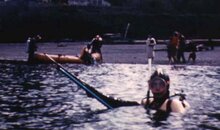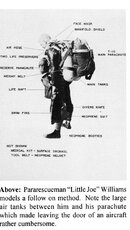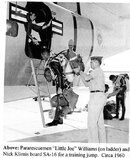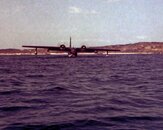Sam,
I'm going to say that the SPG you are talking about had a problem when pressurized in that it was inflexible and hard to see. It probably also had no O-ring seal to allow it to be rotated so as to be readable.
One more thing...I'm looking at my Aquamatic first stage (I have a full Aquamatic regulator too, but it's in the outside shed and it's late), and there is no HP port at all. There is only one port, and it is for the low pressure hose. That hose has a different fitting too, as it is not an O-ring fitting, but a brass-on-brass contact fitting much like the twin manifolds of that time (and some even today). So one thing holding back the SPG was that there was no provision on really old (1950s) regulators for mounting one.
The first Calypso regulator had a stem gauge, but it required a weird washer setup with the O-ring to seal the HP hole. So that would inhibit use of an SPG (although I have used the washer to mount a SPG on an Original Calypso).
Dale,
Picture #3 was also taken off Okinawa in 1968, but we were using our twin 72s with the single hose regulator when a single hose regulator had a single hose.

We used USD Calypso (second generation) almost exclusively at that time, even though they had yet to be approved by the U.S. Navy Experimental Diving School (no single hose regulator was approved at that time, due to breathing characteristics--exhalation). But we were doing parascuba jumps, and the double hose regulator was too vulnerable to having the hoses ripped apart during our parachute opening, with the risers hitting things as we exited the aircraft. I've enclosed some photos of pararescuemen outfitted in various configurations of jump gear.
Note that the photos of Nick Kalmis and Little Joe Williams were taken in the 1950s, and Pararescue was using the Mistral regulator at that time. We did not await the blessings of the U.S. Navy to get better gear. By the way, they were jumping from the HU-16B Albatross, which had a "hatch" rather than a door and was notoriously hard to get out of. I had a number of jumps, including parascuba, from the HU-16, and we were thankful for the narrower tanks in the late 1960s. The photo I took below of the Albatross in the water shows the reason for the hatch rather than a door.
Note also that there are no SPGs in this gear. The less we had to tangle a parachute, the better.
SeaRat
PS--My first rig, which I described above, cost about $65 as I recall. My only income was from picking strawberries and beans. We got $0.25 per carrier, which was 8 hillocks (little boxes about 4 inches by 4 inches by 4 inches). A carrier was a wooden box with high handles that allowed these 8 little boxes to be carried in the field. We had to fill those to overflowing before turning them in too. I picked probably an average of 12-16 carriers a day, so that was $3-4/day. So that was between sixteen days of picking strawberries and 22 days of picking strawberries to get that gear. We were on our knees all day picking these berries (about 9 AM to 3 PM, taken by bus to the fields). I wore out the knees of several jeans that way; today kids buy jeans already worn, but we earned our worn-out jeans. I got the scuba unit used, a 38 cubic foot tank...yellow...and had my choice between a USD Mistral, a Dacor Dial-a-Breath, and the Healthways SCUBA, and I choose the Healthways SCUBA. It had blue hoses, and breathed really smoothly on the surface. The Mistral and Dacor would also have cost more, as I recall. This probably started me on the road to getting used gear too!












